Physical Address
304 North Cardinal St.
Dorchester Center, MA 02124
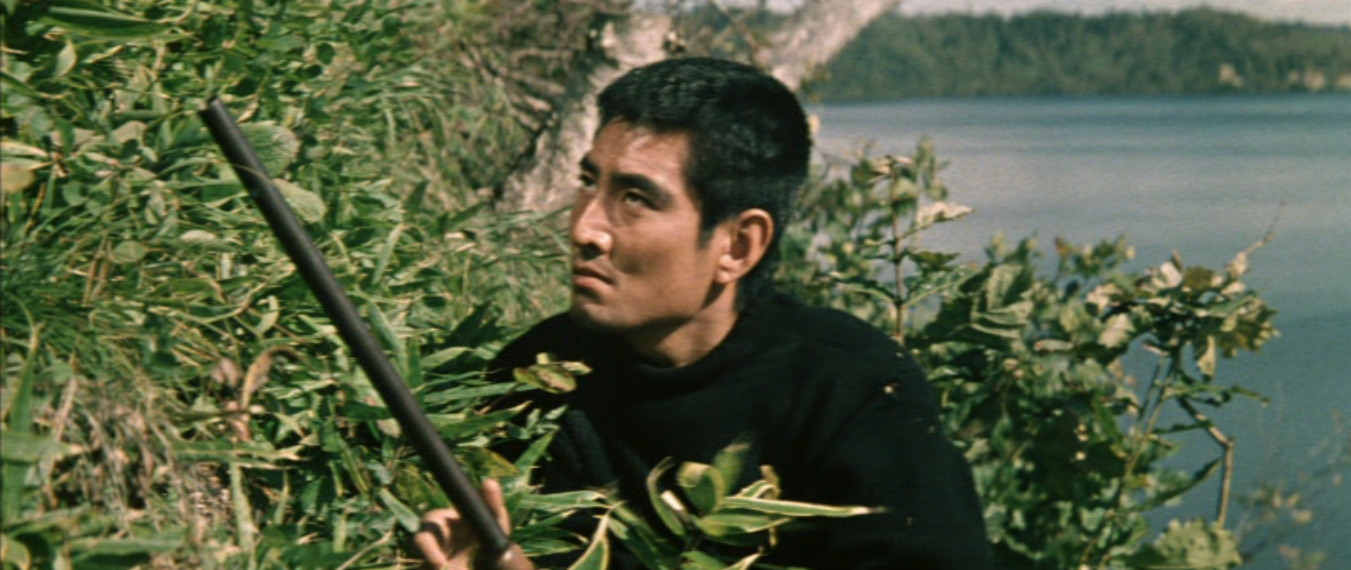
(Continued from page 2)
Like so many movies on racial themes released during these same years in the U.S., The Outsiders has an authenticity problem, not least because this film, like all commercial films under capitalism, was created primarily to make money for its producing studio, not to reform the social or political status quo. And is a film like this invariably exploitative, despite its makers’ good intentions? For just as Hollywood preached tolerance while often offering outstanding black actors like Dorothy Dandridge secondary or demeaning roles (and treating black artists shabbily in general), so this movie seeks to champion the Ainu while rigorously excluding them from its production. As far as I know, all the main and even all the significant secondary characters are played by Japanese actors, not Ainu ones. Similarly, all the talent behind the camera is – again, as far as I know – also Japanese, including, of course, the director and screenwriter (not to mention the Japanese novelist, Takeda Taijun, from whose book the tale was adapted).
As Marcos P. Centeno Martín, in his article about filmic representations of the Ainu over the decades, has written, alluding to the work of the late Edward Said, “Orientalism was not about landowners but about who has the right to represent who[m].”1 Centeno Martín cites as among the first depictions of the Ainu in commercial entertainment films (as opposed to documentaries and travelogues) not only The Outsiders, but another film released two years later, The Rambler Rides Again (Daisogen no wataridori, Saitō Buichi, 1960), one of the popular “borderless action” (mukokuseki akushon) movies that Nikkatsu specialized in during the late 1950s and 1960s.2 3 The author then critiques both Uchida’s and Saitō’s films for falsely presenting the Ainu as a romanticized and exotic “other,” inaccurately depicted (he claims) to evoke Native American characters and customs in Hollywood pictures.4
But though, as we’ve already shown, the Hollywood Western strongly influenced the visual look and iconography of Uchida’s film, there are, I believe, several problems with equating these two movies. The Rambler Rides Again was, like the other films in “The Rambler” (wataridori) series, not a “social consciousness” picture, but merely a commercial vehicle for its star, Kobayashi Akira – the persecution of the Ainu is merely a plot point – whereas Uchida’s film was definitely not such a vehicle, as Takakura Ken at this point wasn’t yet a major star. And whereas in The Rambler Rides Again, the Ainu are presented, according to Centeno Martín, as so helpless as to require the Japanese “wandering” hero to fight for them against a greedy, racist businessman,5 the Ainu protagonist in The Outsiders is himself the main warrior against racial injustice. Furthermore, the other indigenous characters in Uchida’s work are depicted not as exotic, but to various degrees assimilated, however uncomfortably, with the dominant culture. (Most of them wear modern, “Western” clothing.)
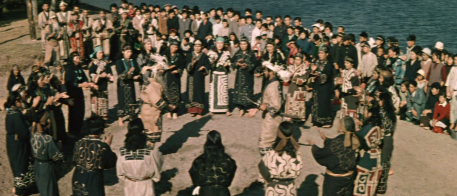
Finally, Centeno Martín points out that in Saitō’s film, Ainu characters are shown dancing around a bonfire, a custom associated with the Sioux rather than the Ainu.6 I did not detect anything as blatantly false in Uchida’s depiction of Ainu native customs (though admittedly I’m no expert on that subject). However, Uchida does not explain the origin or the meaning of these rituals, so the viewer remains in the dark about their cultural significance.
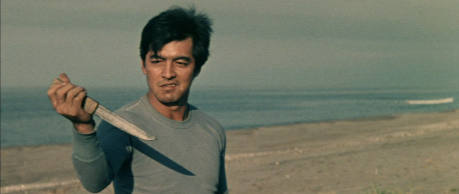
To its credit, the film never claims to tell its story of cultural oppression from an internal perspective: as already mentioned, the leading female character, Yukiko, through whose point-of-view the audience perceives the events of the narrative, is Japanese. And also to its credit, the film doesn’t falsely ennoble its Ainu characters: Oiwa Takeshi, who is part-Ainu, discriminates against his own people, and the proud hero Byakki is presented very ambivalently.
Most interestingly, the film controversially presents its protagonist as fiercely anti-assimilationist, a stance that was years ahead of its time, since, according to Naruse scholar Catherine Russell, this was not to be the mainstream position of Ainu rights organizations until the 1970s, inspired partly by worldwide movements of other indigenous peoples.7 Although the ending of the film can be seen as conservative – Alexander Jacoby interprets its main theme as “the impossibility of sustaining the Ainu as a race apart, and thus the inevitability of miscegenation” – the character of Byakki is transformed at the end into a powerful symbol of the persistence of rebellion.
What ultimately convinces us – or at least convinces me – to accept the authority of the film’s moral position is that the strong stance Uchida takes in support of this oppressed people is wholly consistent with his career-long sympathy for – and empathy with – the downtrodden and persecuted. Just as his 1957 work The Eleventh Hour was the first known Japanese theatrical film to deal with the issue of discrimination against resident Koreans in Japan (still a very serious problem), so this film, however imperfect, was the first to introduce anti-Ainu discrimination as a major theme. This was perhaps a necessary first step before Japanese cinema could include, in an entertainment film, authentic Ainu actors speaking their dialogue in the Ainu language, as in Fukunaga Takeshi’s recent Ainu Mosir (2020).
A year after the release of The Outsiders, Naruse Mikio came out with his own film about the Ainu called Whistling in Kotan (Kotan no kuchibue, 1959, aka, Whistle in My Heart).8 It’s fascinating to compare these works by two great but very different directors.9 Unlike Uchida’s film, which deals almost entirely with adults, Naruse’s focus, atypically for him, is on young people, specifically a teenage Ainu sister and brother: Masa (Kōda Yoshiko) and Yutaka (Kubo Ken), who together suffer a long series of soul-crushing vicissitudes, largely but not entirely due to their ethnic heritage.
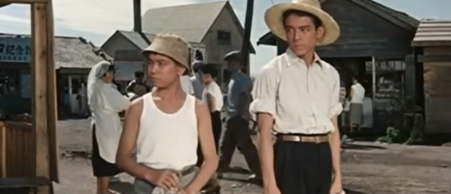
Interestingly, Yutaka and an activist cousin, Koji, encounter a group of Ainu in colorful costumes performing traditional rituals similar to the ones presented neutrally in Uchida’s film, but the cousin disparages these “false” images of his people, designed, he claims, solely for the consumption of gullible tourists. There’s also a scene in which, as in Uchida’s movie, a Shamo “liberal” finds the limits of his tolerance strained by the prospect of intermarriage with an Ainu. However, Naruse’s version is much more devastating (for a Western audience anyway), because the hypocritical Japanese man is played by Shimura Takashi, the benign father figure of numerous Kurosawa films.
And yet the Ainu characters that Naruse presents to us as “authentic” – that is, as ordinary people living their lives in the modern world, rather than noble or ignoble savages – are not far at all from the Japanese protagonists of Naruse’s other films of the period, in which various geisha and mistresses and bar hostesses struggle, despite their semi-outcast status, for a modicum of social respect. The big difference, of course, is that those female Naruse characters had chosen their situations to one degree or another, whereas poor Masa and Yutaka became “outsiders” simply by being born Ainu.
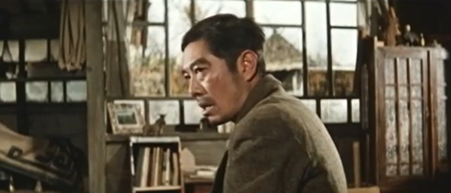
In the film’s dispiriting final act, the two siblings, now orphaned, are placed at the mercy of a nasty Ainu uncle, very well played by one of Japan’s wonderful character actors, Sazanka Kyū, who the following year would have a small but memorable role in Kurosawa Akira’s The Bad Sleep Well (Warui Yatsu Hodo Yoku Nemuru, 1960). This relative degrades and exploits them, consigning them to a decidedly bleak future. As Hayley Scanlon in her review points out, this is very unsubtle; however, it’s not at all implausible, particularly in Naruse’s world, in which family members, unlike Ozu’s, so often betray one another.
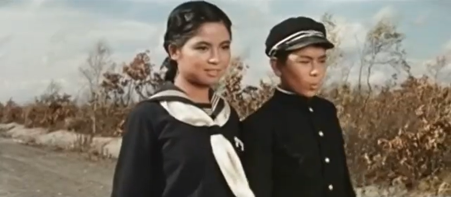
The real problem in this “problem picture” turns out to be not racial discrimination per se, but human nature, which by definition can’t be reformed. The two young people react to this truth with what Scanlon calls “false cheerfulness,” determined against seemingly impossible odds to better their lot. However, this very falseness – optimism for which there’s absolutely no objective justification – is, I would maintain, precisely what makes them heroic in Naruse’s eyes. The smiling, whistling teenagers walking off into the distance at the fade-out are Naruse’s equivalent of the Seven Samurai, or of the heroic but overzealous activist Byakki: exemplary folk battling, each in his or her own way, the most formidable imaginable adversity.
A powerful if at times problematical condemnation of the oppression of Japan’s indigenous Ainu people, The Outsiders, characteristically for Uchida, boasts solid performances – particularly from Takakura Ken and Kagawa Kyōko – and dazzling visuals.
Midnight Eye (Jasper Sharp) (Enthusiastic review of the film)
J. B. Spins (Joe Bendel)
Senses of Cinema (Alexander Jacoby) (Rather detailed critique of the film within a general overview of Uchida’s career)
Tokyo FilmEx 2004 Retrospective (Brief summary)
Flicker Fan (blog) (Brief, rather negative review)
Centeno Martín, Marcos P. “The Fight for Self-Representation: Ainu Imaginary, Ethnicity and Assimilation.” Alphaville: Journal of Film and Screen Media, Issue 13, Summer 2017 (The author cites this film and another Japanese film, claiming that their representations of the Ainu people are inadequate)